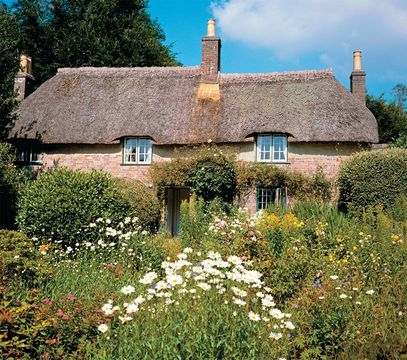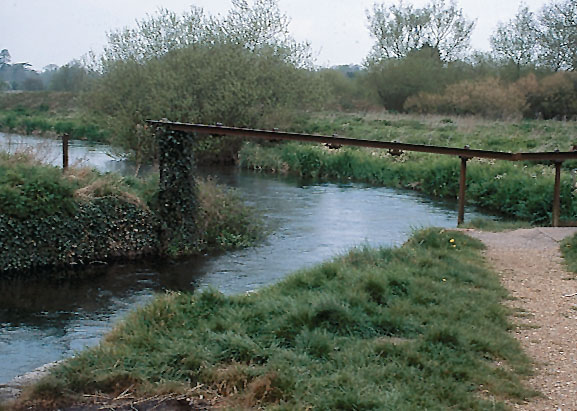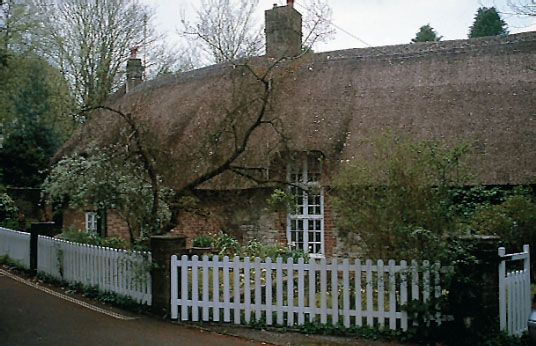
A picturesque cottage in Dorchester, Dorset.
Of all the great classic novels of English literature, The Mayor of Casterbridge is the single work that readers in the early 21st century can recognizably walk through virtually scene by scene.
The Romans called their town Durnovaria; we know it today as Dorchester. They were latecomers, though. By the time Roman legionnaires arrived on the plains of central Dorset, the place had already been a fortress, Celtic command and control center of the Durotriges tribe, and an agricultural heartland for at least 800 years.
It’s not surprising that the Dorset countryside hereabouts is known as Thomas Hardy Country. The great Victorian novelist and poet was born in 1840 just outside of town in the tiny hamlet of Higher Bockhampton and spent most of his life here. Dorchester became the fictionalized Casterbridge, the spiritual heart and geographic center of the region he called Wessex— roughly the territory of the West Saxons, the ancient kingdom of King Alfred the Great.
Read more
When Hardy knew the land and its people in the Victorian 19th-century, the Dorset countryside was agricultural; it had little changed in the previous 400 years. Both its rhythms of life and its economy were completely dependent upon the land. Its fortunes rose and fell with the weather, the rain, the crops and the market for grain.
As Casterbridge, Dorchester featured prominently in Hardy’s works. He set many poems here and many of the scenes of Under the Greenwood Tree, The Trumpet Major and Far from the Madding Crowd. Hardy’s 1885 tragic novel The Mayor of Casterbridge, though, is set almost entirely within walking distance of Dorchester’s town center —the marketplace and the Corn Exchange.
Of course, Dorchester has changed a good deal since Thomas Hardy knew it. It was changing dramatically during his lifetime, and by the time of his death in 1928 was scarcely the rural backwater he knew as a boy and fictionalized in his art. Hardy readily acknowledged that he was writing of the town and its life as he remembered it as a boy. In that sense, The Mayor was a “historical novel” when he wrote it. Indeed, one of its themes is that the old rural way of life unbroken for centuries was being changed by the “modern” world.
Today, the market town is the county town of Dorset. Its population has doubled in the last generation, through the natural accretion of its own attractiveness as a place to live and work, and through the development of Prince Charles’ planned community of Poundbury on the Duchy of Cornwall estates at Dorchester’s outskirts.
Remarkably enough, Hardy would today find central Dorchester very recognizable, as would Michael Henchard, the eponymous protagonist of one of his most popular novels. In fact, of all the works we think of among the “classic English novels,” The Mayor of Casterbridge is singularly the novel that we can virtually walk through today, though its face is altered some from the mid-1800s when the novel is set.
Behind the traffic and carparks, the Boots and the Barclays, lies Casterbridge. When the commerce of the day has finished and the streets are quiet, the ghosts of Casterbridge emerge, to walk the Walks that marked the boundaries of ancient Roman Durnovaria, poach fish and fowl from the surrounding countryside and regale the present with its ancient past. Even if you’re not a particular fan of Thomas Hardy, or familiar with The Mayor of Casterbridge, this is a place where past meets present in unusual and interesting intersection.
The center point of the town is where the busy High Street meets now pedestrianized Cornhill. An obelisk erected in 1754 marks the Town Pump. At this juncture, the town’s lively biweekly market was held for generations. Today, stalls of street sellers still set up along Cornhill, though the now weekly Wednesday market has moved to larger quarters on the southern outskirts.
The Town Hall, or Corn Exchange, occupies one corner of the intersection, St. Peters Church another. Behind them, on the “Bull Ring,” is Dorchester Prison, Dorset’s county jail. Across the street from the Corn Exchange, Hardy set “High Place Hall,” Lucetta Templeman’s house (though he based the description on Colliton House a few blocks away).
The bells of St. Peters rang out often in The Mayor, and, in fact, they tolled the curfew as recently as the beginning of World War II. Hardy himself was in the belfry when the ringers rang in the New Year of 1885; that spring he finished The Mayor.
“The building before whose doors they had pitched their music-stands was the chief hotel in Casterbridge, namely the King’s Arms. A spacious bow window projected into the street over the main portico, and from the open sashes came the babble of voices, the jingle of glasses, and the drawing of corks.”

Ten Hatches Weir. Via: DANA HUNTELY
“He went on past the cottage in which the old local hangman had lived and died, in times before that calling was monopolized over all England by a single gentleman; and climbed up by a steep back lane into town.”
“The river here was deep and strong at all times, and the hatches on this account were raised and lowered by cogs and a winch. A path led from the second bridge over the highway to these Hatches.”
Just down the High Street, the bowed entrance of the King’s Arms Hotel marks the principal hostelry in Dorchester—now as in the early 1800s. The old coaching inn was the principal stop for mail coaches between London and Salisbury. The first Casterbridge scene of The Mayor takes place here when Henchard’s estranged wife Susan and supposed daughter arrive in town. The narrative returns again and again to the King’s Arms. In its low-beamed, dark public bar, locals still gather and share the gossip in a broad Dorset accent.

Hangman’s Cottage. DANA HUNTELY
Farther east on the High Street is All Saints Church, made redundant in 1972 and now a museum, and the site of The Three Mariners Inn, which Hardy noted poignantly had been pulled down by the time he wrote The Mayor. At the foot of the hill, the Town Bridge, or Swan Bridge, crosses a small branch of the River Frome. The layabouts of the time used to hang out there, uncaring of “the glare of the public eye.”
Several hundred yards farther on, Grey’s Bridge crosses the principal branch of the river, and demarcates between town and country. Then, as now, Casterbridge “… had no suburbs—in the ordinary sense. Country and town met at a mathematical line.” Beyond lie the water meadows and corn fields Hardy calls Durnover Moor. A metal plaque on the bridge still promises that anyone found defacing the bridge will be liable to be transported for life.
A small path through the meadows to the north side of Grey’s Bridge leads up river 50 yards or so to the pool called Ten Hatches Weir. Here, Michael Henchard intended to drown himself, when he was arrested by finding his own effigy floating in the water.
Turning south from Grey’s Bridge, King’s Road leads into the parish of Fordington, what Hardy called Durnover. Mill Street on the left marks the unrecognizable locale of Hardy’s Mixen Lane. The shadowy lower reaches of Dorchester society lived and gathered there in “the hiding place of those who were in distress and debt.” The small stream where poachers used to cross from the fields to their homes has long been filled in. It was “a great part pulled down” by the time Hardy wrote.
Nearby on Fordington Green (Durnover Green) is St. George’s Church. Susan Henchard was buried in the churchyard, noted as the site of a Romano-British burial ground. Here, Elizabeth-Jane met Lucetta when she came to tend her mother’s grave. Inside the church, the gravestone of a Roman soldier rests at the back of the nave, its 1st-century Latin inscription the earliest known in Dorset.
Across the triangular green, from the corner of Gallows Hill, the South Walks lead back into the center of town. Dorchester’s “Walks” were first planted in the 1740s. These pedestrian avenues of flowering chestnuts and limes marked the original Roman boundaries of the town. They form a clear quadrangle, except where the River Frome itself roughens the square as part of its northern and eastern edges.
The South Walks lead to South Street, the nether end of Corn-hill. Then as now a principal commercial street of the town, this is where Michael Henchard lived in his years as a thriving corn merchant. His house, marked with a blue plaque, has long been a branch of Barclays bank. Where Henchard’s granaries and work yards were outback, a pay & display car park sprawls, serving Waitrose and the shops.
“It chanced that on a fine spring morning Henchard and Farfrae met in the chestnut walk which ran along the south wall of the town. Each had just come out from his early breakfast, and there was not another soul near.”
Another plaque, over the Gorge Café, identifies where Hardy worked as an apprentice architect 1856-1860. The legend on the café’s front windows claims: “Great food is our pleasure, even Thomas Hardy would be delighted.” The 17th-century almshouse of Napper’s Mite still stands, now a tea room and restaurant, as does the Antelope Hotel, presently an arcade of small shops.
From the old market square, the High Street leads west to Top o’ Town. A statue of Thomas Hardy sits near the roundabout. From there, West Walk marches south, where Donald Farfrae launched his public entertainment—arching the canopy of trees with the canvases that usually covered hay ricks.
To the north, Colliton Walk (Chalk Walk) leads toward the River Frome. In the northwest corner of the ancient town, long after Hardy’s time, archaeologists uncovered the remnants of the best-preserved Roman townhouse yet found in Britain.
At the hill’s bottom, where the Frome curls north into the countryside, sits the Hangman’s Cottage. In Hardy’s day, every county had its own executioner on retainer, and, after all, this is where the prison was. If defacing a bridge could get you transported for life, it’s easy to imagine that the Dorset hangman was kept employed.
Roman ruins are indeed everywhere in Dorchester. Just below Top o’ Town on the West Walk stands a carefully preserved section of the original Roman wall of the town. Farther to the south on the Weymouth Road is the Maumbury Rings, “The Ring.” In actuality, its origins date back to around 2,500 BC. The Romans adapted it, however, for their purposes, turning it into a coliseum that seated 10,000-12,000 legionnaires and locals for circuses, meetings and ceremonial purposes: “It was to Casterbridge what the ruined Coliseum is to modern Rome, and was nearly of the same magnitude.”
Here at the Maumbury Rings, Susan and Henchard first meet in secret assignation. “The dismal privacy which the earthen circle enforced” became the scene of several clandestine meetings. Even today, within its ramparts, it is quiet—the bustle of traffic and the noise of life beyond strangely shut out. Just across the street, “the Budmouth road,” an impressive new concrete skatepark just opened. Ironically, it eerily resembles the contours of the Maumbury Rings.
Not much farther south from town lies Maiden Castle. Its presence is largely why Dorchester came into existence as a Roman town. Rising off the surrounding plains on a chalk monadnock, the Iron Age hillfort is the largest such Celtic fortress known. Five miles of irregular concentric ramparts more than 60 feet in height enclose a 50-acre plateau where more than 1,000 people made home and refuge. The Romans took the fort in AD 43 and settled themselves and the survivors in Durnovaria. Henchard went to the “the prehistoric fort called Mai Dun” to spy on Elizabeth-Jane and Farfrae walking on the Budmouth road. Sheep have grazed on Maiden Castle for more than a millennium, the traditional method of maintaining chalk downland.
Another ancient hillfort to the northwest of town, called Pummery, is the “elevated green spot” where Henchard planned his ill-fated fete—sadly eclipsed by Farfrae’s festivities on the West Walk.
The Dorset County Museum stands on the High Street just a few steps from Cornhill. Among its many galleries and displays on Dorchester’s long history and rural past, the museum houses the largest collection of Hardy memorabilia in the world—first editions, playbills, translations, and the like—as well as a faithful reconstruction of the writer’s study from his home, Max Gate, on the edge of town.
For Hardy fans, the surrounding countryside and villages are replete with locales significant to his life and work. At the tiny church in Stinsford his family worshipped for generations. They are in the churchyard, with the graves of his two wives. At Higher Bockhampton, the thatched cottage that was Hardy’s Birthplace sits on the edge of Thorncombe Wood and a vast wasteland that became Egdon Heath in his work.
Casterbridge itself, though, is the writer’s heart. Despite the town’s obvious pride in its intimate connection with Thomas Hardy, this is not Bath or Stratford-upon-Avon, building its life on celebrity. Few folk seem to pay much attention, and the literary tourists come and go without particular notice apart from their appreciated custom in the pubs and shops. Dorchester is just more charming and genuine because of that. And when the twilight comes, and you stand alone in the hollow of the Ring, those ghosts echo back a long time.
Visiting Thomas Hardy’s homes
Both Max Gate and Hardy’s birthplace in Higher Bockhampton are owned by the National Trust today and welcome visitors on a limited schedule.
Max Gate, Alington Avenue, Dorchester, open Sunday, Monday and Wednesday, 2-5.
Hardy’s Cottage, Higher Bockhampton, open mid-March to October 29, Sunday-Thursday, 11-5.
* Originally published in 2016.





Comments